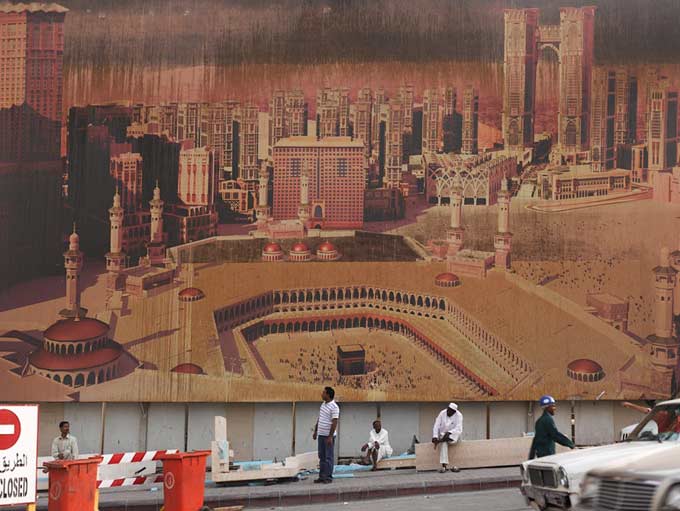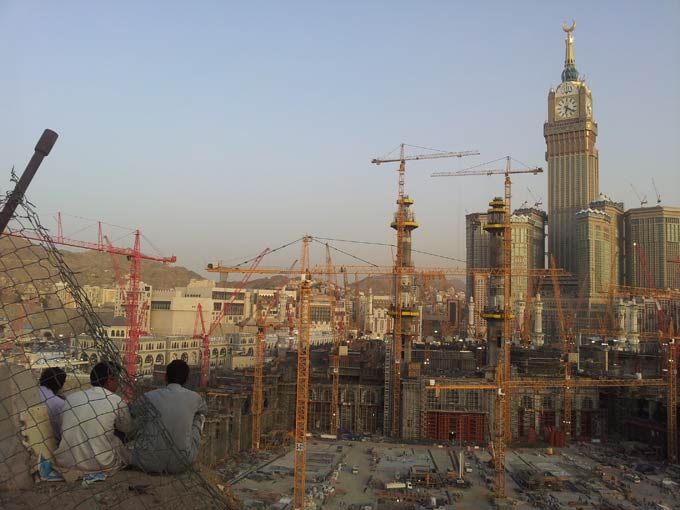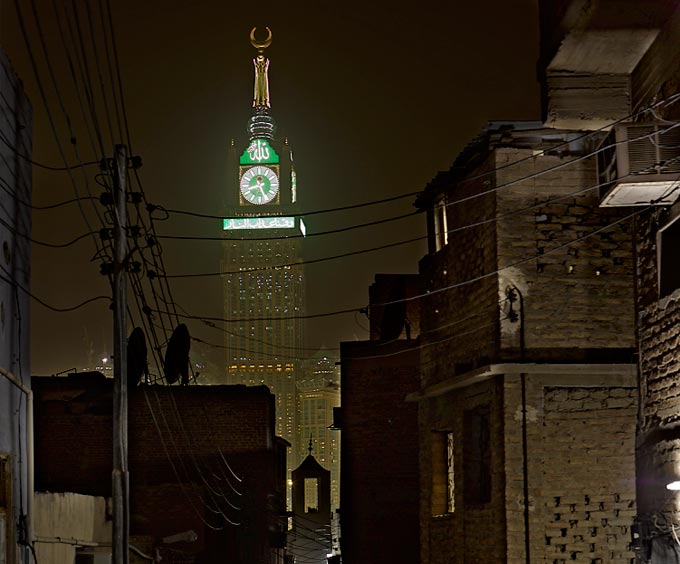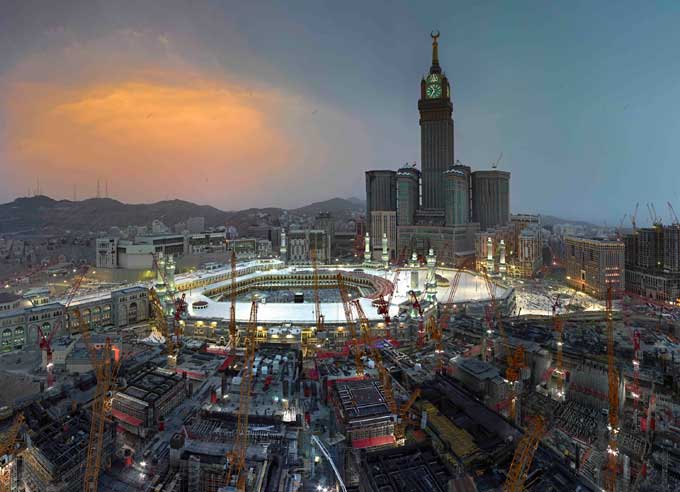This week, approximately three million people are heading to Mecca for the hajj, the annual Muslim pilgrimage that is also one of the five pillars of Islam. For the past three years, artist Ahmed Mater has traveled to Mecca to photograph the recent transformation of the area around the Masjid al-Haram (“Sacred Mosque”), which includes the construction of the Abraj al-Bait Towers, a hotel complex and clock tower that is now the second-tallest building in the world. In the wake of these developments, Mater reflects on what today’s Mecca represents to him. His photos and text offer a poetic and personal glimpse of his experience, as well as a rare inside perspective for non-Muslims, who are not permitted to enter the city.
—

This photo is taken 500 meters from the Ka’aba, which is at the center of the Masjid al-Haram in Mecca. When I arrive from the coastal city of Jeddah, I leave my car near this spot and walk from here to the mosque. This billboard is like an advertisement for the Mecca skyline to come. It covers up the construction going on at Omar Mountain, which is named after the second sahabi (“companion”) of the Prophet Mohammad.
Today, there is a popular TV show about the seventh-century Caliph called Omar.
—

This photo shows the demolition site where additions to the mosque and its surroundings will be built. There used to be houses here, not a fenced-off area. These three men, I think, lived in those houses, so it is emotional for me to see them here. They come here to witness what is happening. It is the end, the climax of this expansion.
I was a small boy the first time I visited Mecca. I don’t remember the city exactly—I remember it through a 3D viewer my family gave to me, which showed it as simple and beautiful, with crowds of people. Over the years, I’ve been following Mecca as it changes, and I recognize what is different: huge buildings and cranes. Lots of jackhammers.
—

Here is a picture of the houses I just mentioned. I took this picture before they were demolished to clear the way for the expansion of the mosque and the construction of new hotels. Although this is an older photo, it remains with me as a powerful memory, coming to mind whenever I visit the demolition site. It is part of a narrative I hold with me every time I go to Mecca.
—

This photo is taken from the Fairmont Hotel, which offers three types of room: one with a view of the city, one with a view of the mosque, and one with a view of the Ka’aba. The room overlooking the Ka’aba, which you see here, is the most expensive at $3,000 a night.
The hotel is not even a year old and it is booked all the time. Some Khalijis—Arabs from the Gulf—from big companies have booked rooms for every night of the year, even though they will only stay for a week. When I asked to enter a room, I was told they were all booked, and I paid room service staff just to give me one hour inside.
—

At this bus depot you can see people coming from countries and regions around the world: Malaysia, Andalusia, America, China, and so on. They come in groups, and each one wears its own version of white. People dress in modest white cloth for the hajj; this ihram clothing, which cannot be stitched and must not have any scent, symbolizes unification. Pilgrims are supposed to forget everything singular about their own lives and enter a similar spiritual state. There is no difference in race, color or class. Everyone comes together to meet one another and do hajj for one God. Hajj is one of the five pillars of Islam.
—

I love this picture because it reminds me of the Empire State Building. Workers like the one you see here stand at great heights, and many come from Afghanistan or India to do this difficult work. Although it is dangerous, they consider it a good job because they are serving Beit Allah (“House of God”).
—

I like the moment when Maghrib (“evening”) prayers start—that’s when I took this photo, from the top of a minaret. The sun is setting, and you can see a pale orange glow to the left of the Abraj Al-Bait Towers. As the prayers start, all the cranes stop. And it looks like they are praying. That is what I felt watching them.
—

They make the gasoline into a celebrity at this station. It’s like an advertisement. You can see it from far away. I always stop to refuel.
On the way home, I usually play some music in my car. This time, I listen to a Sufi song performed by Mohamed Abdu, the most famous singer in Saudi Arabia. He comes from the southwestern province of Aseer, and people across the Middle East call him “the artist of Arabs.” Here in the Hejaz area (the western coastal region, which includes Aseer and Mecca), music is very popular—especially among the young—despite complaints from the more religious. Each time they shut a music shop down, another one opens up.
This piece, commissioned by Creative Time Reports, has also been published in Foreign Policy.

